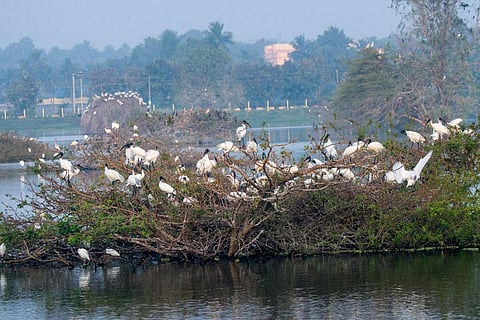

The second phase of the first ever All Tamil Nadu Bird Census 2022 was conducted in the state on February 12 and 13, focusing on a synchronised survey covering 339 wetlands from 25 districts. This consisted of 14 inland water bird sanctuaries, including Vedanthangal bird sanctuary. Salem had 97 inland wetlands – the highest – followed by Chennai with 28. In the second phase, Tirunelveli district recorded the highest population of water birds with numbers exceeding 33,000 of 41 water bird species. A synchronised survey is done to get a roughly accurate estimate on the population of both resident and migratory water birds while looking at the species richness and species diversity and analyse the changing trends due to various environmental stressors.
“Among all the districts, Tirunelveli has recorded the highest population of waterbirds with numbers exceeding 33,000 of 41 waterbird species. Koonthankulam Bird Sanctuary and its satellite wetlands attracted about 2,000 bar-headed goose, which is the highest recorded in this census. These goose are world’s highest flying birds”, said Principal Chief Conservator of Forests and Chief Wildlife Warden of Chennai, Dr Shekhar Kumar Niraj in a press release. He added that the uncommon Comb Duck was also seen in the sanctuary.
During the second phase, more than 100 species of birds were identified and long walls of Greater flamingos were spotted in Point Calimere and Ramanathapuram areas. The dominant species recorded from Tirunelveli district were Spot-billed Pelican and Painted Stork. The near-threatened and uncommon Oriental Darter was seen in maximum numbers at Koonthankulam, Vedanthangal and Vaduvoor bird sanctuaries.
Further, two species – Common Pochard and River Tern – recorded during this census are listed under the IUCN’s (International Union for Conservation of Nature) Vulnerable category. Other vulnerable species, including 20 individual Common Pochards were recorded in a satellite wetland of Koonthankulam Bird Sanctuary and River Terns were recorded in Anamalai Tiger Reserve.
The press release read that Small Pratincole, an uncommon species to southern India and Red-headed Bunting, a rare migratory species from Central Asia were also sighted in Anamalai Tiger Reserve; Fulvous Whistling-Duck was spotted in Kunnathur tank of Madurai.
Overall, while the water bird population recorded was lower due to the prevailing high water condition in most of the wetlands, the species diversity was quite high, said Shekhar. “The census was done from the angle of understanding bird species diversity, and its richness. Diversity is the indicator of changing habitats,” he added.
Speaking about the reason behind this first-of-its-kind exercise, he said, “The first reason is that the diversity of birds and its population will tell us about how the environment is doing and whether climate change is really leading to changes in ecological parameters. Second reason is that Tamil Nadu has got one of the highest wetland networks in the country and all the wetlands are never surveyed for the birds, and lastly, an attempt is being made to create a Tamil Nadu bird atlas for the first time.”
“Birds are very good indicators of the ecosystem. If we know the trend of the bird species diversity and migration pattern, it becomes important in light of environmental changes like climate change, anthropogenic factors like wetland destruction. We can also know how much India contributes to bird diversity to the world”, he added.
According to the enumerators and wildlife authorities of Tamil Nadu, the survey recorded the presence of near-threatened species like Spot-billed Pelican, Eurasian Spoonbill, Oriental Darter, Painted Stork, and Black-headed Ibis. These rare birds, according to the survey enumerators, were seen in thousands with nestlings and the state wildlife department said this was a good sign.
The first phase of this survey was conducted on January 28 and 29, focusing on coastal and marine bird habitats. The third phase will be conducted focusing on the terrestrial birds.